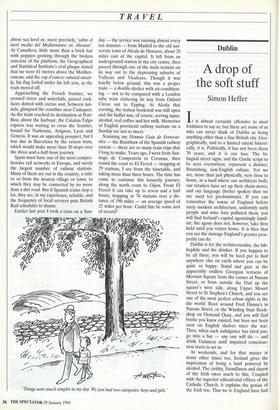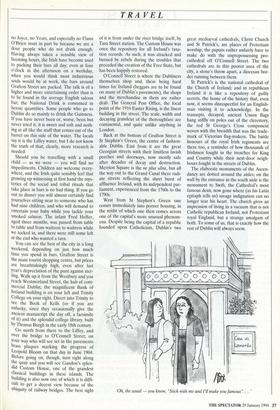Dublin
A drop of the soft stuff
Simon Heffer
It is almost certainly offensive to most Irishmen to say so, but there are some of us who can never think of Dublin as being anything other than a fine British city. Geo- graphically, and to a limited extent histori- cally, it is. Politically, it has not been these 70 years, and it is our loss. The bi- lingual street signs, and the Gaelic script to be seen everywhere, represent a distinct, flourishing, non-English culture. Yet we are, more than just physically, very close to home, in a land where our architects built, our retailers have set up their chain-stores, and our language (better spoken than we are used to) predominates. If you can remember the towns of England before nasty modern architecture, uniformly surly people and wine bars polluted them, you will find Ireland's capital agonisingly famil- iar; the agony does not, however, take firm hold until you return home. It is then that you see the damage England's greater pros- perity can do.
Dublin is for the architecturalist, the bib- liophile and the drinker. If you happen to be all three, you will be hard put to find anywhere else on earth where you can be quite so happy. Stand and gaze at the apparently endless Georgian terraces of Merrion Square from the corner of Nassau Street, or from outside the Dail up the square's west side, along Upper Mount Street to St Stephen's Church, and you see one of the most perfect urban sights in the the world. Root around Fred Hanna's in Nassau Street, or the Winding Stair Book- shop on Ormond Quay, and you will find books you knew existed, but have not been seen on English shelves since the war. Then, when such indulgence has tired you, go into a bar — any one will do — and drink Guinness until impaired conscious- ness starts to set in.
At weekends, and for that matter at many other times too, Ireland gives the impression of being a land powered by alcohol. The civility, friendliness and charm of the Irish owes much to this. Coupled with the superior educational offices of the Catholic Church, it explains the genius of the Irish too. That we in England have had
TRAVEL
no Joyce, no Yeats, and especially no Flann O'Brien must in part be because we are a dour people who do not drink enough. Having always taken a sensible view of licensing hours, the Irish have become used to packing their bars all day; even at four o'clock in the afternoon on a weekday, when you would think most industrious souls would be at work, the bars around Grafton Street are packed. The talk is of a higher and more entertaining order than is to be found in the average English saloon bar; the National Drink is consumed in heroic quantities. Some people who go to Dublin do so mainly to drink the Guinness. If you have never been or, worse, been but never tried it, it is sweet and soft and noth- ing at all like the stuff that comes out of the barrel on this side of the water. The locals say it is the Liffey water, but I do not know the truth of that; clearly, more research is needed.
Should you be travelling with a small child — as we were — you will find no impediments. Children are welcome every- where, and the Irish quite sensibly feel that growing up witnessing at first hand the mys- teries of the social and tribal rituals that take place in bars is no bad thing. If you go out to dinner you will almost certainly find Yourselves sitting near to someone who has had nine children, and who will demand to entertain your baby while you tackle your smoked salmon. The infant Fred Heffer, aged three months, was passed from table to table and from waitress to waitress while we tucked in, and there were still some left at the end who wanted a turn.
You can see the best of the city in a long weekend, depending on just how much time you spend in bars. Grafton Street is the main tourist shopping centre, but prices are breathtakingly high, even after last Year's depreciation of the punt against ster- ling. Walk up it from the Westbury and you reach Westmorland Street, the hub of com- mercial Dublin; the magnificent Bank of Ireland building is on your left and Trinity College on your right. Divert into Trinity to see the Book of Kells (or if you are unlucky, since they occasionally give the ancient manuscript the day off, a facsimile of it) and the splendid college library, built by Thomas Burgh in the early 18th century.
Go north from there to the Liffey, and over the bridge to O'Connell Street; on your way who will see set in the pavements brass plaques marking the progress of Leopold Bloom on that day in June 1904. Before going on, though, turn right along the quay and you will see Gandon's splen- did Custom House, one of the grandest classical buildings in these islands. The building is also now one of which it is diffi- cult to get a decent view because of the ubiquity of railway bridges. The best sight of it is from under the river bridge itself, by Tara Street station. The Custom House was once the repository for all Ireland's taxa- tion records. As such, it was attacked and burned by rebels during the troubles that preceded the creation of the Free State, but has been happily restored.
O'Connell Street is where the Dubliners themselves shop and, these being hard times for Ireland (beggars are to be found on many of Dublin's pavements), the shops and the merchandise in them are rather drab. The General Post Office, the focal point of the 1916 Easter Rising, is the finest building in the street. The scale, width and decaying grandeur of the thoroughfare are continental, and quite unlike anything in London.
Back at the bottom of Grafton Street is St Stephen's Green, the centre of fashion- able Dublin. East from it are the great Georgian streets with their limitless lavish porches and doorways, now mostly safe after decades of decay and destruction. Merrion Square is the ne plus ultra, but all the way out to the Grand Canal there radi- ate streets reflecting the short burst of affluence Ireland, with its independent par- liament, experienced from the 1760s to the 1790s.
West from St Stephen's Green one comes immediately into poorer housing, in the midst of which one then comes across one of the capital's more unusual phenom- ena. Despite being the capital of a republic founded upon Catholicism, Dublin's two great mediaeval cathedrals, Christ Church and St Patrick's, are places of Protestant worship; the papists rather unfairly have to make do with the unprepossessing pro- cathedral off O'Connell Street. The two cathedrals are in this poorer area of the city, a stone's throw apart, a diocesan bor- der running between them.
St Patrick's is the national cathedral of the Church of Ireland; and in republican Ireland it is like a repository of guilty secrets, the home of the history that, even now, it seems disrespectful for an English- man visiting it to acknowledge. In the transepts, decayed, ancient Union flags hang stiffly on poles out of the clerestory, the red St George's Cross component woven with the breadth that was the trade- mark of Victorian flag-makers. The battle honours of the royal Irish regiments are there too, a reminder of how thousands of Irishmen fought in the trenches for King and Country while their next-door neigh- bours fought in the streets of Dublin.
The elaborate monuments of the Ascen- dancy are dotted around the aisles; on the wall by the entrance in the south aisle is the monument to Swift, the Cathedral's most famous dean, now gone where (as his Latin epitaph tells us) savage indignation can no longer tear his heart. The church gives an impression of living in a vacuum that is not Catholic republican Ireland, not Protestant royal England, but a strange amalgam of both. To some of us, that is exactly how the rest of Dublin will always seem.
`Oh, the usual — you know, "Stick with me and I'll make you famous". . . '



































































 Previous page
Previous page